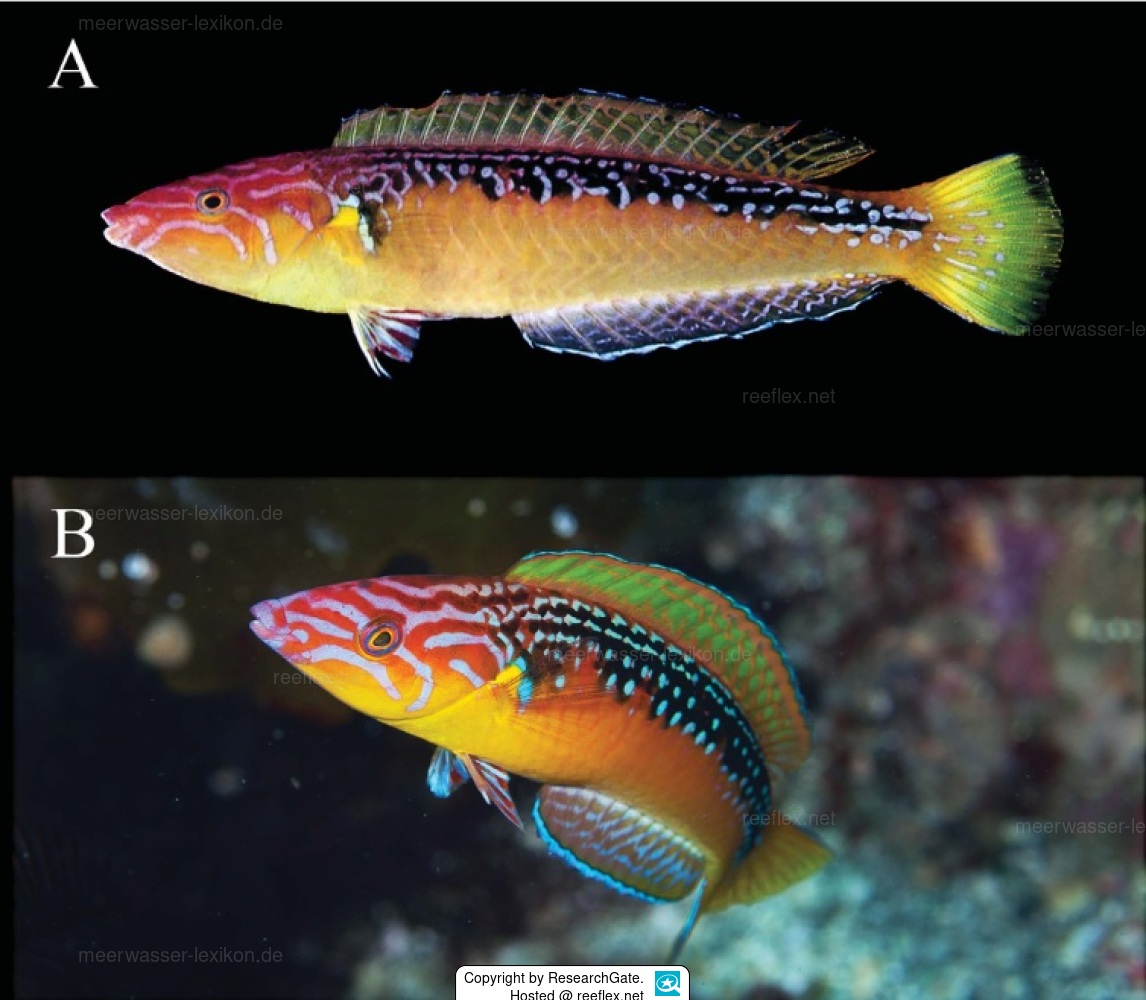Info
2020 A new wrasse species was discovered in Japan, Pseudojuloides paradiseus Tea, Gill & Senou 2020, the initial description of the wrasse also includes a revision redescription of the wrasse Pseudojuloides elongatus Ayling & Russell, 1977.
Males are bright yellowish-orange to orange-pink, their upper body is heavily covered in black with 3 - 5 rows of metallic blue spots, while females are unmarked and reddish-orange to brick red.
Etymology:
The specific species name "paradiseus " comes from Latin for "paradise", referring to the strikingly colorful live coloration of the males.
This new wrasse species appears to inhabit scree zones with distinct kelp and macroalgae growth.
Pseudojuloides paradiseus is a member of the Pseudojuloides elongatus complex.
Occurrence:
Pseudojuloides paradiseus is sporadically distributed in the following locations in southern Japan:
Izu-Oshima and Miyake Island, Izu Islands; Tateyama Bay, east of Sagami Bay; Izu Oceanic Park, east coast of Izu Peninsula, Sagami Bay; Osezaki, west of Izu Peninsula, Suruga Bay; Kushimoto, Wakayama Prefecture, southern end of Kii Peninsula; Kashiwa Island, Shikoku; Mishima Island, Yamaguchi Prefecture; Myoken-ura, Amakusa, Kuwamoto Prefecture; Yunomoto, Iki Island, Nagasaki; Okino-shimaIsland, Munakata, Fukuoka; and Yakataishi, Karatsu, Saga Prefecture.
Scientific reference:
Two New Species of Pseudojuloides from Western Australia and Southern Japan, with a Redescription of Pseudojuloides elongatus (Teleostei: Labridae)
ResearchGate
DOI:10.1643/CI-19-316
Yi-Kai Tea, Anthony Gill, Hiroshi Senou
Jumping guard
A jumping guard prevents (nocturnal) fish from jumping out.
Wrasses, blennies, hawkfishs and gobies jump out of an unprotected tank in fright if their night rest is disturbed, unfortunately these jumpers are found dried up in the morning on carpets, glass edges or later behind the tank.
https://www.korallenriff.de/en/article/1925_5_Jump_Protection_Solutions_for_Fish_in_the_Aquarium__5_Net_Covers.html
A small night light also helps, as it provides the fish with a means of orientation in the dark!
Males are bright yellowish-orange to orange-pink, their upper body is heavily covered in black with 3 - 5 rows of metallic blue spots, while females are unmarked and reddish-orange to brick red.
Etymology:
The specific species name "paradiseus " comes from Latin for "paradise", referring to the strikingly colorful live coloration of the males.
This new wrasse species appears to inhabit scree zones with distinct kelp and macroalgae growth.
Pseudojuloides paradiseus is a member of the Pseudojuloides elongatus complex.
Occurrence:
Pseudojuloides paradiseus is sporadically distributed in the following locations in southern Japan:
Izu-Oshima and Miyake Island, Izu Islands; Tateyama Bay, east of Sagami Bay; Izu Oceanic Park, east coast of Izu Peninsula, Sagami Bay; Osezaki, west of Izu Peninsula, Suruga Bay; Kushimoto, Wakayama Prefecture, southern end of Kii Peninsula; Kashiwa Island, Shikoku; Mishima Island, Yamaguchi Prefecture; Myoken-ura, Amakusa, Kuwamoto Prefecture; Yunomoto, Iki Island, Nagasaki; Okino-shimaIsland, Munakata, Fukuoka; and Yakataishi, Karatsu, Saga Prefecture.
Scientific reference:
Two New Species of Pseudojuloides from Western Australia and Southern Japan, with a Redescription of Pseudojuloides elongatus (Teleostei: Labridae)
ResearchGate
DOI:10.1643/CI-19-316
Yi-Kai Tea, Anthony Gill, Hiroshi Senou
Jumping guard
A jumping guard prevents (nocturnal) fish from jumping out.
Wrasses, blennies, hawkfishs and gobies jump out of an unprotected tank in fright if their night rest is disturbed, unfortunately these jumpers are found dried up in the morning on carpets, glass edges or later behind the tank.
https://www.korallenriff.de/en/article/1925_5_Jump_Protection_Solutions_for_Fish_in_the_Aquarium__5_Net_Covers.html
A small night light also helps, as it provides the fish with a means of orientation in the dark!







 ResearchGate
ResearchGate




















